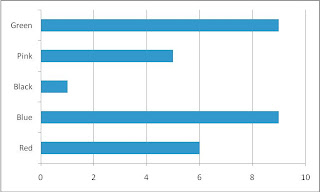Male 15 Female 15

This shows that our target audience can be aimed at both females and males as we received half and half on our results.
2.What age are you?
12-15- 3 16-19- 26 20-23- 1 Other

This also shows that our documentary will more be aimed at people between the age of 16-19 as our results were 26 out of 30.
3.What is your favourite colour?
Red-6 Blue-9 Black -1 Pink-5 Green-9

This shows that our target audience preferred the colours green and blue out of 5 colours including: green, blue, black, red and pink. As our results show this, we are likely to use these colours in certain ways during our documentary.
4.What is your favourite shop and why?
Art-1
Boohoo.com-1
Primark-1
HMV-3
Internationale-1
ASOS-1
New look-4
Hollister-1
Frenzy-1
RAN- 2
The Style-1
Topshop/Topman-4
Pop Boutique-2
Paperchase-1
Waterstones-1
Quggins-5

This bar chart shows that the shops, Quiggins, Topshop/Topman and New Look are very popular with our target audience.
5.What subculture would you relate yourself with?
Emo-0
Skater-3
Mosher
Casual-12
Indie-5
Vintage-2
Chav-1
Sporty-1
Other -3
None-3

The pie chart above shows that 12 out of 30 people would relate themselves to a casual subculture. Although our documentary will relate to various subcultures, we know what our audience would like to see on screen.
6.What is your favourite genre of music?
Dance-5
House
R&B-3
Rock-5
Indie-7
Dubstep/D&B-1
Metal
Reggae-1
Pop-5
Other-3

This chart shows that the musin genre, indie, is the most favourite with a total of 7 out of 30 people. Other high scores include Dance and Pop. This will help in relation to our documentary so we know what music to use in the backgrounds etc.
7.What night do you normally watch TV?
Sunday-9
Monday-3
Tuesday
Wednesday
Thursday-1
Friday
Saturday-5
Everyday-12

As you can see above, most people watch TV everyday/night, on the other hand, Sunday and Saturday also received high votes as they got a total of 9 and 5. This could help with the decision of scheduling our documentary.
8.What channel do you prefer to watch?
BBC1-3
BBC2
ITV1-4
Channel 4-15
Five
Other-8

This pie char shows that half the people we asked for questionnaires prefer to watch Channel 4 compared to BBC1, BBC2, ITV, Five and Other. This also could help with the scheduling for our documentary.
9.What hobbies do you have in your spare time?
Sport-10
Academic-4
Music-6
Socialising-10

This shows that most people in their spare time enjoy things such as sport and socialising. This could affect our documentary as we could include cutaways of people socialising within their subcultures and also sport being a subculture in a unique way.
10.What times do you watch TV?
Breakfast-3
Daytime-3
Kids
Primetime-7
Post watershed-17

This chart shows that most people will watch TV at post watershed time, and this will help with the scheduling for our documentary.
11.Have you ever been discriminated against because of the way you dress?
Yes-11
No-19

This pie charts that 11 people out of 30 have been discriminated against because of the way they dress. This will be reflected in our documentary because we want to show people that everyone is equal no matter what subculture they are, if any subculture.
12.Would you change the way you look due to discrimination?
Yes-0
No-30

This barchart shows that nobody would change the way they look due to discrimination. This will also be reflected in our documentary as people should be who and what they are no matter what they look like.
13.What makes you dress the way you do?
Celebrities-6
Musicians-6
Magazines-2
Trends-9
To be different-4
1 step ahead-3

This pie chart shows that most people dress the way they do because they like to follow the trends. 9 people out of 30 said this. 12 people out of 30 said they dress like they do due to musicians and celebrities. This shows that many people follow fashion from other people. We would like this to show in our documentary.










